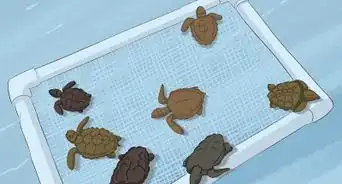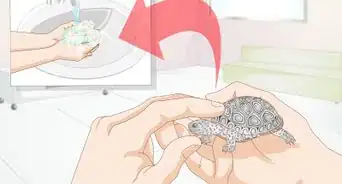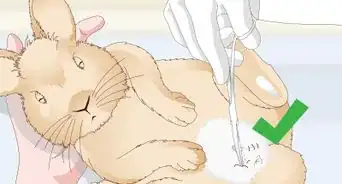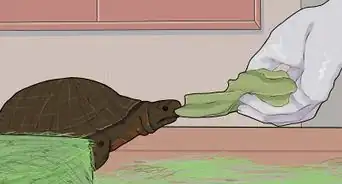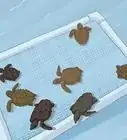This article was co-authored by Pippa Elliott, MRCVS. Dr. Elliott, BVMS, MRCVS is a veterinarian with over 30 years of experience in veterinary surgery and companion animal practice. She graduated from the University of Glasgow in 1987 with a degree in veterinary medicine and surgery. She has worked at the same animal clinic in her hometown for over 20 years.
wikiHow marks an article as reader-approved once it receives enough positive feedback. This article received 67 testimonials and 81% of readers who voted found it helpful, earning it our reader-approved status.
This article has been viewed 2,664,920 times.
If you keep pet turtles, it's nice to know if you've got boys or girls. However, unlike many mammals, turtles have no external genitalia. This makes determining their sex much more difficult, but it's not impossible. The differences between male and female turtles can be subtle and are easier to spot if you have one turtle of each sex so that you can compare. If you only have one turtle, then look for as many clues as possible to try to determine the turtle's gender.
Steps
Examining the Turtle’s Shell
-
1Look at your turtle’s shell. The turtle’s shell, or carapace, differs slightly between male and female. An adult female turtle has a slightly longer shell than an adult male has.[1]
- As a means of sexing the turtle, this method is limited because you need to make sure that the turtle is fully grown. You may assume that a turtle is male due to a smaller size when it actually has more growing to do.
- There can be an overlap in size between a large male and a small female, so it’s not possible to predict the gender based on size alone.
-
2Examine the turtle’s plastron. The underside of the shell, which covers the turtle equivalent of a belly, is called the plastron. To check the plastron, pick the turtle up with care. They do not like to be handled and may try to bite, so grasp the turtle from the tail end so it can't reach around and snap at you. Gently turn the turtle over so you can see the underside. In male turtles, the plastron is slightly concave (curving inwards), whereas a female's is flat.[2]
- A concave plastron allows for a male turtle to fit over a female’s shell during mating without rolling off.
- The female’s flatter plastron gives her more room internally in which to grow eggs.
Advertisement -
3Check the turtle for a tail notch. Male turtles often have a small 'V,' or notch, at the rear end of the carapace. This is to accommodate the tail when the turtles mate. Otherwise the tail might be crushed against the underside of his shell.[3]
-
4Look for species-specific clues. Some species of turtles have gender-specific external features. Some species that may reveal gender through coloring are:
- The American box turtle: 90 percent of the time, male box turtles have red or orange irises while the female has brown or yellow ones. Also, the female has a tendency to have a higher-domed, more rounded shell, whereas the male has a lower shell with more of an oval or oblong appearance.
- Sun turtle: If the turtle's underbelly has blue coloring, it's a male. If the underbelly does not have blue coloring, it's a female.
Checking for Details
-
1Examine the turtle’s front claws. Male turtles use their front claws during mating rituals with female turtles. They also use their front claws to fight and to claim and defend their territory. Therefore, the claws on the males' front legs tend to be longer than the claws of female turtles. Again, this is more obvious when you have two turtles of different sexes to compare with each other.[4]
- The Red-eared Slider species particularly shows a pronounced difference between the male and female front claws.
-
2Look at the turtle’s cloaca. Both male and females have an opening or vent located on the underside on the tail. This is called the cloaca, and it is located slightly differently depending on the gender.[5]
- The female's cloaca is rounder and more star-shaped than the male's. It is found much closer to her body, at the base of her tail where it joins her body, almost disappearing into the shell.
- The male's cloaca is longer and more slit-like. It is located in the last third of the tail, towards the tip.
-
3Determine the turtle’s tail size. The male's genitalia are located within the tail, and to accommodate them, the tail is longer and thicker than a female’s. The female's tail is shorter and thinner.[6]
- Be aware that there is an overlap in normal sizes between male and female, so this can give you a hint, but it is not a foolproof way of sexing a turtle.
-
4Combine multiple signs to reach a conclusion. The best approach to sexing a turtle is using a combination of the suggested steps to come up with the most likely gender for the turtle. Bear in mind that some methods are less reliable than others in determining the gender of your turtle.
- If all the signs point in one direction, then it's more likely than not that you've determined the gender accurately. However, if the signs are mixed, you may wish to take your turtle to a vet to be certain.[7]
- If you're not sure what conclusion to draw, wait until the turtle is older and try again. It is extremely difficult to sex a baby turtle.
- Be aware that you might have to wait years until your turtle is fully grown and you can determine the gender effectively.
Expert Q&A
-
QuestionWhat does the shell look like for a male and female?
 Pippa Elliott, MRCVSDr. Elliott, BVMS, MRCVS is a veterinarian with over 30 years of experience in veterinary surgery and companion animal practice. She graduated from the University of Glasgow in 1987 with a degree in veterinary medicine and surgery. She has worked at the same animal clinic in her hometown for over 20 years.
Pippa Elliott, MRCVSDr. Elliott, BVMS, MRCVS is a veterinarian with over 30 years of experience in veterinary surgery and companion animal practice. She graduated from the University of Glasgow in 1987 with a degree in veterinary medicine and surgery. She has worked at the same animal clinic in her hometown for over 20 years.
Veterinarian The appearance of the shell is more heavily influenced by external, environmental factors than by gender. For example, poor nutrition and lack of calcium may lead to "terracing" or ridges within individual scutes. However, there are no useful or consistent differences in the shell between the genders when it comes to telling male from female.
The appearance of the shell is more heavily influenced by external, environmental factors than by gender. For example, poor nutrition and lack of calcium may lead to "terracing" or ridges within individual scutes. However, there are no useful or consistent differences in the shell between the genders when it comes to telling male from female. -
QuestionDoes this apply to tortoises as well?
 Pippa Elliott, MRCVSDr. Elliott, BVMS, MRCVS is a veterinarian with over 30 years of experience in veterinary surgery and companion animal practice. She graduated from the University of Glasgow in 1987 with a degree in veterinary medicine and surgery. She has worked at the same animal clinic in her hometown for over 20 years.
Pippa Elliott, MRCVSDr. Elliott, BVMS, MRCVS is a veterinarian with over 30 years of experience in veterinary surgery and companion animal practice. She graduated from the University of Glasgow in 1987 with a degree in veterinary medicine and surgery. She has worked at the same animal clinic in her hometown for over 20 years.
Veterinarian Yes, most of the general gender differences described in this guide apply to tortoises as well. This includes the size differences, curve of the plastron, and tail length; however, tortoise tail notches can be subtly different such that the male has a more "V" shaped notch, whilst the female's is "U" shaped.
Yes, most of the general gender differences described in this guide apply to tortoises as well. This includes the size differences, curve of the plastron, and tail length; however, tortoise tail notches can be subtly different such that the male has a more "V" shaped notch, whilst the female's is "U" shaped.
Warnings
- Wash your hands every single time you handle a turtle. Some turtles carry salmonella and, while it won't harm the turtle, it can harm you.[8] Do not put unwashed hands near your mouth or nose until you've washed them with warm water and soap. Make sure children do so after handling turtles too.⧼thumbs_response⧽
References
- ↑ Reptile Medicine and Surgery. Maders. Saunders
- ↑ Reptile Medicine and Surgery. Maders. Saunders
- ↑ Reptile Medicine and Surgery. Maders. Saunders
- ↑ Reptile Medicine and Surgery. Maders. Saunders
- ↑ Reptile Medicine and Surgery. Maders. Saunders
- ↑ Reptile Medicine and Surgery. Maders. Saunders
- ↑ http://www.turtlecare.net/home/turtle-topics-parent/gender
- ↑ All Turtles, Turtle FAQs, http://www.allturtles.com/turtle-newbie/turtle-faqs/
About This Article
The most reliable way to tell if a turtle is male or female is to examine the bottom of its shell. If it caves inward, the turtle is most likely male, and if it doesn't cave inward, it's most likely female. You can also inspect the turtle’s tail to guess what sex the turtle is. Male turtles tend to have larger and wider tails than females. Also check the turtle’s cloaca, which is the small hole located under the tail. If the cloaca is closer to the tip of the tail than the shell, the turtle is likely male. If the cloaca is closer to the shell than the tip of the tail, the turtle is likely female. Finally, you can check the color and markings on the turtle. In most turtle species, males are more colorful and have more distinct markings to attract mates. For more tips from our Veterinary reviewer, like how to determine your turtle’s gender based on its species, read on!








